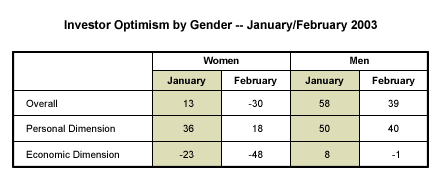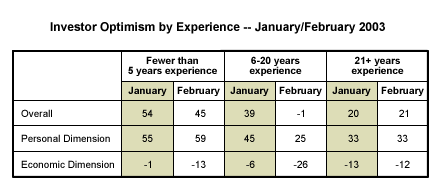Investor optimism has hit an all-time low. When the UBS/Gallup Index of Investor Optimism launched in October 1996, the baseline measurement of overall optimism was 126. By February 2003, it had plummeted to 9. Grim economic news has disheartened investors all over the country. But as the January and February 2003 Index data* show, some investors are glummer than the rest, and their points of view may be a flag to the rest of us.
Battle of the Investing Sexes
Overall, female investors tend to be more cautious about their buys than male investors are, but women's portfolios tend to do better. The German bank, HypoVereinsbank, found that its female clients outperformed its male clients by 3%. The University of California at Davis found a 1.4% difference in investment profit between women and men from 1991 and 1997, and single women did 2.3% better than single men. Possible explanations for the difference abound: women tend to do more research, take fewer risks, make fewer trades, and earn less money at their jobs, forcing them to shepherd their resources closer.
So far in 2003, women are extremely pessimistic about investing. Though no one was very optimistic in January, the Index showed a huge difference in overall confidence between men (58) and women (13). On the Personal Dimension of the Index (which measures investors' views of their own situations), male and female sentiments weren't wildly divergent -- men were at 50, women were at 36. But the Economic Dimension (which measures the views of the economy in general) shows a much wider gender gap: 8 for men vs. -23 for women.
Pessimism rose among investors of both genders in February, but among male investors to a lesser degree. Overall, the February Index stood at 39 for men (down 19 points since January) and -30 for women (down 43 points). In January, men and women were relatively close together on the Personal Dimension. By February, they were farther apart: Male investors stood at 40 along the Personal Dimension (down 10 points from January), while women stood at 18 (down 18 points). On the Economic Dimension, the gap widened also; men were down nine points in February to -1, while women were down 25 points to -48.

New Investors, Old Investors, Grim Investors
So far this year there have been significant differences in optimism between experienced investors, inexperienced investors, and those in between.
January
Investors who have been in the market five or fewer years were among the most confident in January -- they were at 54 overall, with 55 on the Personal Dimension, and -1 on the Economic Dimension.
Investors with 6 to 20 years of experience had a slightly dimmer view of the investment landscape. Overall, they were at 39. They stood at a relatively healthy 45 on the Personal Dimension. However, their optimism regarding the national economy was -6.
Investors with 21 or more years of experience were the least optimistic in January. Their overall optimism stood at 20 -- 33 along the Personal Dimension and -13 along the Economic.
February
In February, overall optimism among newer investors (those with five or fewer years of experience) was down, but not out at 45. Optimism on the Personal Dimension was up some for this group, to 59, but the Economic Dimension was down considerably to -13.
Investors who have been in the market for 6 to 20 years were much less optimistic. Overall, the Index was -1 for this group. The Personal Dimension was at 25, but the Economic Dimension tanked to -26, -- a 20-point loss.
Optimism among the most experienced investors changed little between January and February. The overall Index was at 21, the Personal Dimension at 33, the Economic Dimension at -12. Thus, the most experienced investors were the only ones who didn't grow more pessimistic between January and February.

Bottom Line
Optimistic investors are growing more and more scarce. The most cautious investors -- women -- are very pessimistic. The most experienced investors -- who also tend to be older and closer to retirement (or retired) -- are also among the most pessimistic, though their level on the Index of Investor Optimism held steady in February. In any case, both groups should be watched closely in the months to come. If the optimism of the least reckless begins to improve, maybe the optimism of other investors will follow.
*Results for the Gallup/UBS Index of Investor Optimism -- U.S. are based on monthly interviews with about 1,000 U.S. investors, aged 18 and older. For results based on each of these samples, one can say with 95% confidence that the maximum error attributable to sampling and other random effects is ±3%. In addition to sampling error, question wording and practical difficulties in conducting surveys can introduce error or bias into the findings of public opinion polls.

